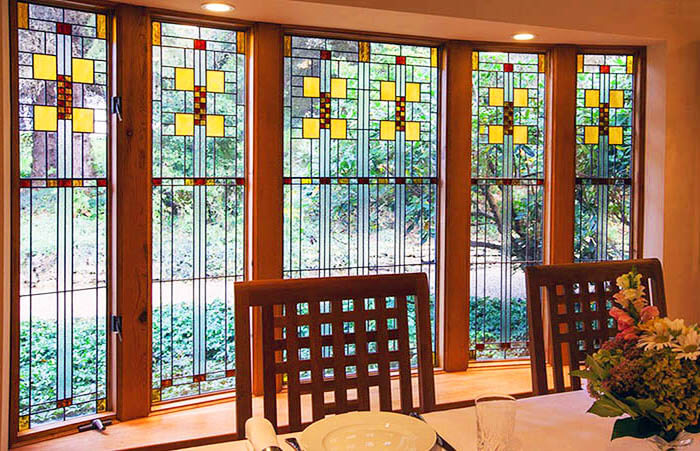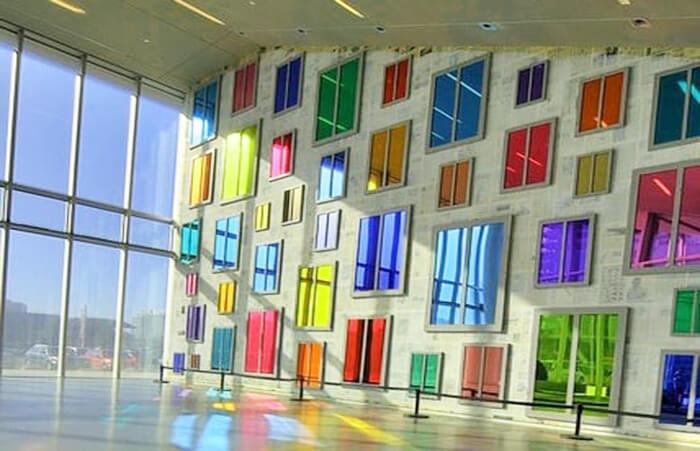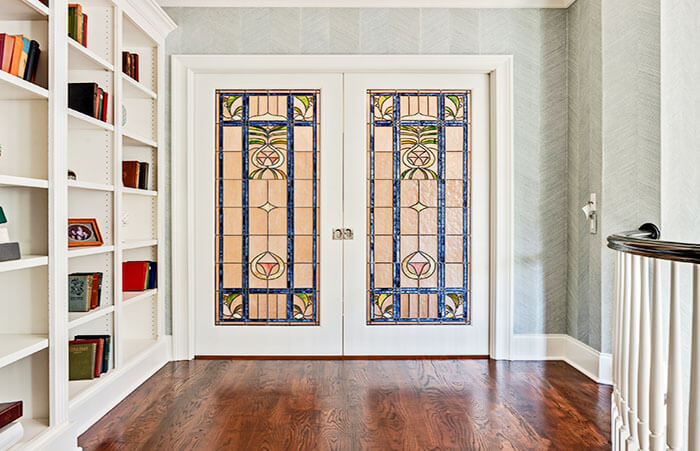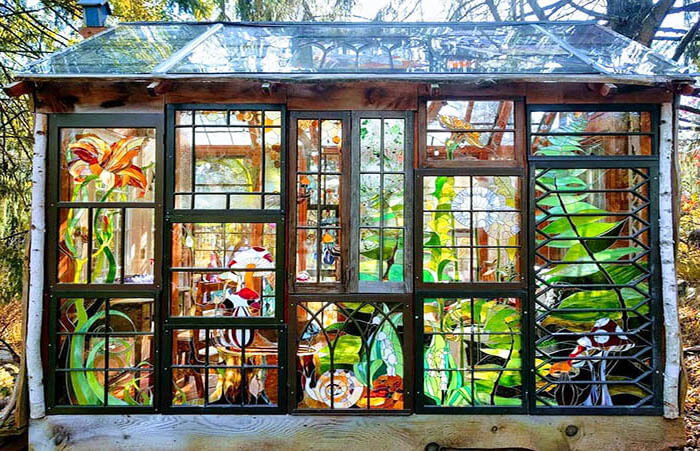The Importance of a Cohesive Design
When designing a space, whether it be a home, office, or public building, one of the most important considerations is creating a cohesive overall aesthetic. A cohesive design means that all of the elements in the space, from the color scheme to the furniture to the architectural details, work together in harmony to create a unified look and feel. Stained glass windows and doors can play a significant role in achieving a cohesive design, adding both beauty and function to a space.
How a Cohesive Design Enhances the Overall Aesthetic of a Space
A cohesive design helps to create a sense of order and harmony in a space. When all of the elements in a room work together, the result is a pleasing and cohesive look that is more aesthetically pleasing to the eye. In contrast, a space with a disjointed or chaotic design can feel unsettling and uninviting.
The Role of Stained Glass in Creating a Cohesive Design
Stained glass windows and doors are often used as a decorative element in a space, adding color, pattern, and texture to the overall design. However, they can also play a functional role in creating a cohesive design. For example, using stained glass windows in a consistent style throughout a home or building can help to tie the different spaces together and create a cohesive look. Similarly, using stained glass doors as a transition between indoor and outdoor spaces can help to seamlessly blend the two areas and create a cohesive design.

Tips for Coordinating Stained Glass Windows and Doors with Other Design Elements
One of the key ways to create a cohesive design with stained glass windows and doors is to coordinate them with other design elements in the space. Here are a few tips for doing so:
Consider the color scheme: Choose stained glass windows and doors that complement the overall color scheme of the space. For example, if the room has predominantly neutral tones, a stained glass window with vibrant colors can add a pop of interest. On the other hand, if the room has a bold color scheme, a more subtle stained glass design may be a better fit.
Match the style: Choose stained glass windows and doors that match the style of the space. For example, in a traditional space, stained glass windows with intricate, classic designs would be a good choice. In a contemporary space, more minimalistic stained glass windows may be a better fit.
Pay attention to proportion: Make sure that the size and scale of the stained glass windows and doors are appropriate for the space. Too small, and they may get lost in the overall design. Too large, and they may dominate the space.

The Process of Creating a Cohesive Design with Stained Glass
Creating a cohesive design with stained glass windows and doors requires careful planning and consideration. Here is a step-by-step guide to the process:
Gathering inspiration and developing a concept: Start by gathering inspiration for your interior stained glass design. Look at pictures of stained glass windows and doors in different styles and consider what appeals to you. Think about the overall aesthetic you want to achieve in the space and how the stained glass can contribute to that. Once you have a general idea of what you want, start sketching out concepts or creating mood boards to help visualize your ideas.
Choosing the right style of stained glass for your space: Once you have a concept in mind, it’s time to choose the right style of stained glass for your space. Consider the style of the space, as well as the function of the stained glass. For example, if you want a traditional look, you might choose stained glass windows with classic motifs such as flowers or geometric patterns. If you want a more modern look, you might choose more minimalistic stained glass windows with clean lines and simple shapes. If you are using the stained glass for privacy or light control, you might choose a design with more opaqueness or a frosted finish.
Incorporating stained glass into the overall design plan: After you have chosen the style of your stained glass windows and doors, it’s time to incorporate them into the overall design plan for the space. Consider the placement of the stained glass and how it will fit into the overall layout of the room. Think about how the stained glass will interact with other design elements, such as the furniture, wall color, and flooring.

Enhancing Cohesion with Custom Stained Glass
One way to create a truly cohesive design with stained glass is to commission a custom piece. Custom stained glass offers a number of benefits, including the ability to create a design that is tailored to your specific needs and the ability to ensure that the stained glass fits seamlessly into the overall design of the space.
The Benefits of Custom Stained Glass for Creating a Cohesive Design
Custom stained glass allows you to create a truly unique piece that is tailored to your specific needs and preferences. You have complete control over the design, including the size, shape, color, and pattern of the stained glass. This means that you can create a piece that perfectly fits into the overall design of your space and enhances the cohesive aesthetic.

The Process of Commissioning a Custom Stained Glass Window or Door
The process of commissioning a custom stained glass window or door typically involves the following steps:
Consultation: The first step is to schedule a consultation with a stained glass artist or studio. During the consultation, you can discuss your ideas and needs, view samples of the artist’s work, and get a sense of their style and process.
Design development: Once you have chosen an artist, the next step is to work with them to develop the design for your custom stained glass piece. This may involve sketching out concepts, creating a detailed drawing, or creating a computer-generated model.
Fabrication: After the design has been finalized, the artist will create the stained glass piece using traditional techniques such as cutting, leading, and soldering. The artist may also use modern technology such as laser cutting and computer-aided design to create the piece.
Installation: Once the stained glass piece is complete, the artist will install it in the designated location. Proper installation is essential to ensure the longevity and beauty of the stained glass.

Ideas for using custom stained glass to tie a space together
There are many ways to use custom stained glass to create a cohesive design in a space. Here are a few ideas:
Use stained glass as a linking element between different areas of a home or building: For example, you might use stained glass doors or windows to visually link the kitchen and dining room, or to create a transition between the indoors and outdoors.
Use stained glass to connect different design styles: If you have a mix of traditional and modern elements in a space, custom stained glass can be a great way to tie everything together. You can use a stained glass design that incorporates elements of both styles, such as a traditional motif in a contemporary color palette.
Use stained glass to add a personal touch: Custom stained glass is a great way to add a personal touch to a space. You can incorporate your own designs or symbols into the stained glass, or you can use it to tell a story or represent your interests or values.

Maintenance and Updating for Cohesive Stained Glass Design
Maintaining and updating stained glass is an important part of preserving a cohesive design in a space. Proper care and maintenance can help to ensure that the stained glass stays in good condition and continues to enhance the cohesive aesthetic of the space. Here are a few tips for maintaining and updating stained glass:
Clean the stained glass regularly: Dust and dirt can accumulate on stained glass, which can dull its appearance and hinder the passage of light. To keep the stained glass clean, use a soft cloth or feather duster to gently dust it on a regular basis. You can also use a mild soap and water solution to clean the stained glass, but be sure to dry it thoroughly to prevent water spots.
Repair any damage promptly: Stained glass is delicate and can be prone to damage. If you notice any cracks, chips, or other damage, it’s important to have it repaired as soon as possible to prevent further damage. A professional stained glass artist or studio can repair the damage and restore the stained glass to its original condition.
Update the stained glass as needed: Over time, you may find that you want to update the stained glass in your space to reflect changing tastes or needs. This could involve replacing an old stained glass window with a new one, or adding a stained glass element to a space that previously didn’t have one. Updating the stained glass can help to keep your design cohesive and current.

The Importance of Professional Installation and Repair for Preserving a Cohesive Design
Proper installation and repair are crucial for preserving the beauty and longevity of stained glass. A professional stained glass artist or studio will have the knowledge and expertise to install the stained glass correctly and to repair any damage in a way that preserves the integrity of the piece. Attempting to install or repair stained glass on your own can result in poor quality work and potentially further damage to the stained glass.

Conclusion
Stained glass windows and doors can be a beautiful and functional addition to any space, adding color, pattern, and texture to the overall design. When used correctly, stained glass can also play a crucial role in creating a cohesive design. By coordinating the stained glass with other design elements, choosing the right style of stained glass for the space, and considering custom options, you can create a cohesive design that is both beautiful and functional. Regular maintenance and updating are also important for preserving the cohesive design of the stained glass over time.
There are many ways to incorporate stained glass into a cohesive design, and the possibilities are endless. Some additional ideas for using stained glass to enhance a cohesive design include:
Using stained glass as a backdrop: Stained glass windows or doors can serve as a beautiful and unique backdrop for a space. For example, you might use a large stained glass window as the focal point of a room, or you might use a stained glass door as a backdrop for a seating area.
Incorporating stained glass into the furniture: Stained glass can also be incorporated into furniture pieces such as tables, cabinets, and bookcases. This can add a touch of elegance and interest to the furniture and help to tie it into the overall design of the space.

Using stained glass to create an accent wall: Instead of using paint or wallpaper to create an accent wall, you might consider using stained glass. This can add a unique and eye-catching element to the space and help to create a cohesive design.
Using stained glass to add privacy: Stained glass can be a stylish and effective way to add privacy to a space. You can use stained glass windows or doors to obscure the view into a room while still allowing light to pass through. This can be particularly useful in spaces such as bathrooms or home offices where privacy is important.
Mixing and matching different styles of stained glass: If you have multiple stained glass elements in a space, you can create a cohesive design by mixing and matching different styles of stained glass. For example, you might use a traditional stained glass window in one room and a more modern stained glass door in another room, and coordinate the colors and patterns to create a cohesive look.
In conclusion, stained glass can be a beautiful and functional element in a cohesive design. By considering the style, placement, and function of the stained glass, and by incorporating custom options as needed, you can create a stunning and cohesive design that enhances the overall aesthetic of your space.


Recent Comments